I’m sure you’ve heard time and time again that nuts are a quick and easy healthy snack. And they are!
In fact, we might be underestimating their healthfulness.
Results from two long-running Harvard studies show that a handful of nuts may help us live longer and healthier lives!
But with so many varieties of nuts around, each touted to be the healthiest, which is the best nut to choose for overall health?
Or for weight loss? Or high cholesterol? And how many nuts counts as a serving?
It’s a confusing subject, which is why I’ve put together this helpful guide to navigate you through the crazy world of nutritious nuts.
Here are nine of the most popular nuts, their nutritional stats, and their main health benefits. Then we can tackle the question on everyone’s minds – ‘which nuts are best?’
Almonds
 America’s most popular nut, almonds clock up around 162 calories per ounce (or 23 kernels) – which is generally considered a serving; along with 14 grams of fat, 3 grams of fiber and 6 grams of protein.
America’s most popular nut, almonds clock up around 162 calories per ounce (or 23 kernels) – which is generally considered a serving; along with 14 grams of fat, 3 grams of fiber and 6 grams of protein.
They’re also rich in vitamin E (containing 37% of your recommended daily value) – something the National Institutes of Health says plays an important role in immune function and has distinctive and proven antioxidant activities.
Almonds also pack in a decent dose of magnesium (19% of your recommended daily value – RDV), which is vital for a huge number of bodily processes.
Studies prove that almonds have earned their place as top nut as they boast a myriad of health benefits.
Firstly, they’re great for both weight loss and stabilizing blood sugar levels.
In a 4 week long study published in the European Journal of Clinical Nutrition, it was found that almonds lowered blood sugar levels – especially when enjoyed as a snack as opposed to with a meal.
And, when consumed as snacks, they also reduced hunger and desire to eat, making them a healthy and effective option for those looking to maintain their weight.
But almonds aren’t just useful for those looking to maintain their weight – they have proven weight loss results too.
In a study featured in the International Journal of Obesity, researchers followed 65 overweight and obese adults (70% of whom had type 2 diabetes) for 24 weeks.
One group ate a 1,000 calorie/day liquid diet supplemented with 3 ounces of almonds while the other group ate the same liquid diet but supplemented with a mix of complex carbohydrates. The two diets were equal in calories and protein but differed in fat.
Those eating the ‘almond diet’ saw an 18% reduction in weight and body mass index, compared with an 11% reduction in the non-almond dieters. And, waist circumference in the almond group decreased by 14%, compared with a 9% decrease in the carbohydrate group.
Other studies have shown that almonds can raise the levels of good bacteria that strengthen the body’s immune system; and can reduce the risk of coronary heart disease.
For other amazing health benefits of almonds, check out this post.
Brazil Nuts
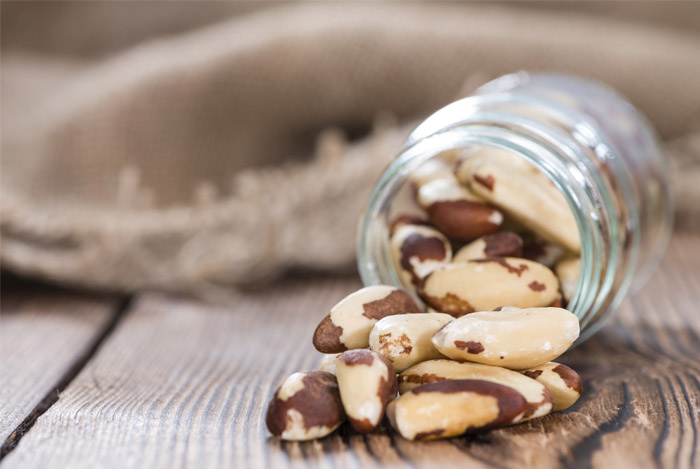 An ounce of Brazil Nuts (roughly six kernels) contains 185 calories, 19 grams of fat, 2 grams of fiber and 4 grams of protein.
An ounce of Brazil Nuts (roughly six kernels) contains 185 calories, 19 grams of fat, 2 grams of fiber and 4 grams of protein.
However, because that serving size will also give you 542 mcg (744% of your daily dose) of selenium, which the National Institutes of Health state is dangerous, it’s recommended that you stick to just two or three nuts.
While the upper safe limit of selenium for adults is 400 mcg, two nuts will still provide almost 275% of your selenium needs, which is plenty!
Brazil nuts can improve high blood fat levels, which can be a risk factor for cardiovascular disease.
In one study, it was found that a single serving of Brazil nut can significantly improve the serum lipid profile of healthy volunteers.
Another study found that selenium rich foods, including Brazil nuts, can lower the incidence of prostate cancer.
The researchers behind the study discovered that men with the highest selenium levels at the start of the study had an incredible 65% lower incidence of advanced prostate cancer than the men with the lowest levels.
Cashews
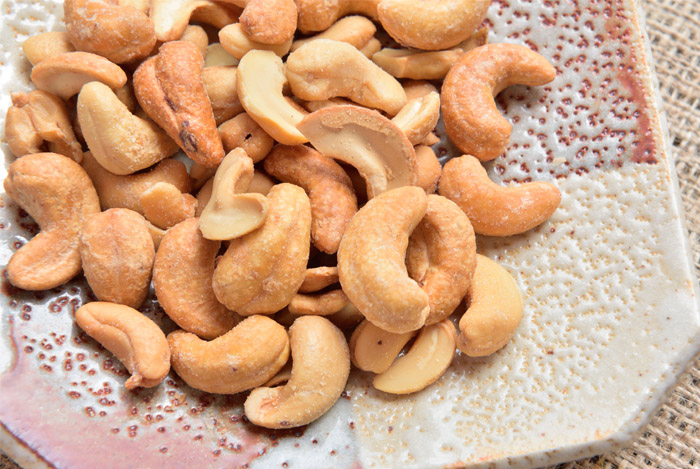 Crunchy cashews provide 155 calories per ounce (17 cashews), 1 gram of fiber and 5 grams of protein, along with 31% of your copper needs, 23% of manganese and 20% of magnesium needs.
Crunchy cashews provide 155 calories per ounce (17 cashews), 1 gram of fiber and 5 grams of protein, along with 31% of your copper needs, 23% of manganese and 20% of magnesium needs.
Just like almonds, cashews are beneficial for controlling blood sugar.
A study, published in the journal Molecular Nutrition and Food Research, looked at the effects of a cashew nut extract on lab rats.
The results show that the extract (anacardic acid) helps sugar to enter bodily cells more easily, thus lowering the amount of sugar circulating in the bloodstream.
While raw cashews are healthy, there is some evidence to show that roasting the nuts (and the thin skin between the nut meat and the shell, called testa) actually produces higher levels of beneficial nutrients.
And, as the roasting temperature increases, so does the antioxidant activity of the cashews.
Hazelnuts
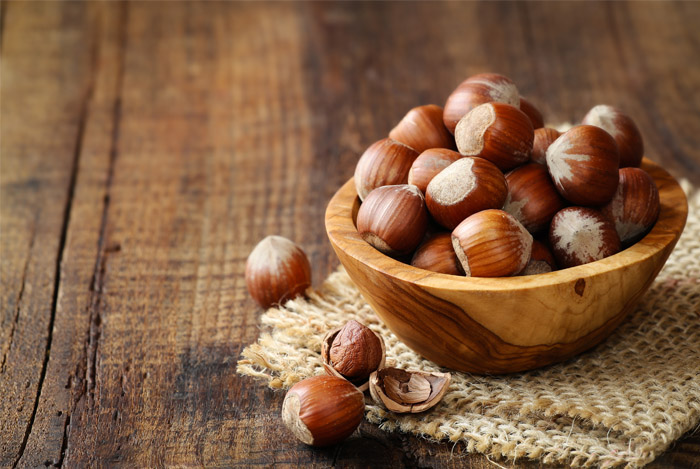 Not just an ingredient in Nutella, hazelnuts actually have some health benefits to them – the most notable being their positive effect on cholesterol levels.
Not just an ingredient in Nutella, hazelnuts actually have some health benefits to them – the most notable being their positive effect on cholesterol levels.
2010 research found that a diet enriched with hazelnuts may help to lower LDL cholesterol (the ‘bad’ kind), triglycerides and total cholesterol.
The following year, another study tested the effects of hazelnuts on 48 patients with mildly high cholesterol levels.
After four weeks, it was found that the participants’ levels of good cholesterol (HDL) were ‘significantly higher’, while their LDL and total cholesterol were ‘significantly lower’. There was no effect on body weight.
An ounce, or 21 nuts, packs in 177 calories, 17 grams of fat, 3 grams of fiber and 4 grams of protein, as well as 87% of your RDV of manganese, 24% of copper and 21% of vitamin E.
You’ll notice that hazelnuts pack in a lot of manganese, something which is necessary for normal brain and nerve function, and plays a role in fat and carbohydrate metabolism, calcium absorption, and blood sugar regulation. Perhaps hazelnuts have more benefits to them than just cholesterol lowering abilities.
Macadamia Nuts
 Bite-sized and almost buttery flavored, macadamia nuts are another popular choice. Just 10 to 12 kernels (an ounce) can provide you with 203 calories, 21 grams of fat, 2 grams of fiber and 2 grams of protein.
Bite-sized and almost buttery flavored, macadamia nuts are another popular choice. Just 10 to 12 kernels (an ounce) can provide you with 203 calories, 21 grams of fat, 2 grams of fiber and 2 grams of protein.
They also give you 50% of your daily dose of manganese and 23% of thiamin – a B vitamin that helps us convert food into fuel and improves the body’s ability to withstand stress.
While macadamia nuts are one of the highest-fat nuts you can eat, most of the fat is the monounsaturated kind (MUFA).
According to the Mayo Clinic, MUFAs can lower your risk of heart disease by improving cholesterol levels and blood vessel function. They may also be beneficial in controlling blood sugar and insulin levels.
A Chinese study, published in 2006 in the International Journal for Vitamin and Nutrition Research, found that 82.6% of the fat in macadamia nuts is monounsaturated.
That’s higher than the levels found in olive oil, which is repeatedly cited as an excellent source of MUFAs, yet it contains just 55% to 83% monounsaturated fats.
Macadamia nuts have been found, in at least one study, to reduce triglyceride levels, total cholesterol, and LDL cholesterol by nearly 10%.
Peanuts
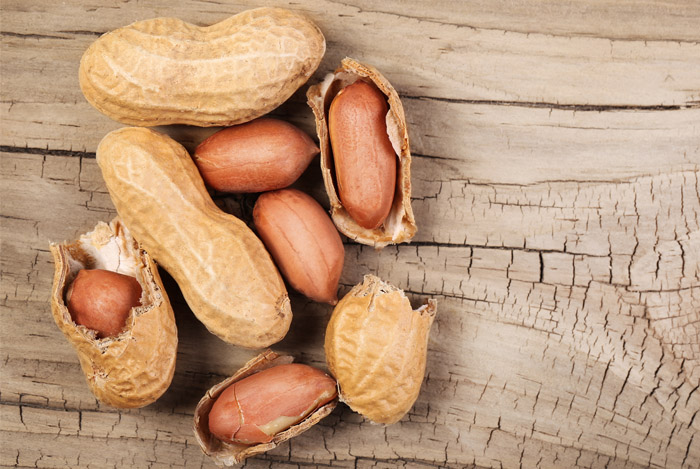 Despite their name, peanuts aren’t technically nuts…they’re legumes! Unlike the other nuts on this list, they grow underground. But since most people consider them to be a nut, I’ve included them here.
Despite their name, peanuts aren’t technically nuts…they’re legumes! Unlike the other nuts on this list, they grow underground. But since most people consider them to be a nut, I’ve included them here.
Whatever they are, they confer a few health benefits.
A huge study, published in JAMA Internal Medicine, looked at nut and peanut consumption in two large groups of people spanning geographic, racial, ethnic, and income boundaries.
The research included 72,000 Americans aged 40 to 79 living in 12 Southern states, of which two-thirds were African American; along with 135,000 men and women in Shanghai, China, aged between 40 and 74.
In the US states, those who regularly ate peanuts were 21% less likely to have died of any cause over a period of five years. In the Chinese group, the death rate in nut-eaters was 17% lower.
And, while peanuts are a high fat food, containing between 44% and 56% fat, according to one piece of research, they actually may be beneficial in weight loss efforts.
One study looked at the effects of peanuts and peanut butter on the weights of 262 sixth grade students in a school-based weight management program.
Analyses revealed that children who ate peanuts were less likely to be overweight or obese than children who didn’t. Peanut eaters also had significantly higher intakes of several vitamins and micronutrients and had lower blood fat and cholesterol levels.
Another study, this time in healthy adult women, showed that when peanuts were given as a substitute for other sources of fat in a low fat diet, participants lost 3 kg over a 6 month period, even though they were asked to maintain, not lose, weight.
Studies also show that regularly eating peanuts can reduce the risk of gallstones in both men and women.
An ounce of peanuts (28 nuts) has 164 calories, 14 grams of fat, 2 grams of fiber and 8 grams of protein – making these faux-nuts the most high-protein nut of them all.
You’ll also be getting 29% of your manganese needs and 19% of your niacin needs. Also known as vitamin B3, niacin is important for general good health, including heart and brain health.
Pecans
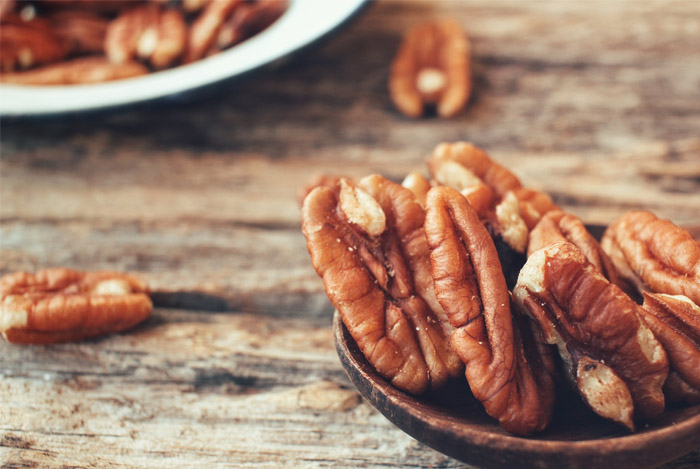 A popular nut in desserts, particularly when paired with maple syrup, pecans have a decadent and rich flavor.
A popular nut in desserts, particularly when paired with maple syrup, pecans have a decadent and rich flavor.
An ounce of them (19 halves) will give you 195 calories, 20 grams of fat, 3 grams of fiber and 3 grams of protein along with 64% of your daily manganese needs.
A study on pecans demonstrates that naturally occurring antioxidants in the nuts may help contribute to heart health and disease prevention.
In addition to being heart healthy, pecans may also boost your brain health, according to an animal study from the University of Massachusetts Lowell.
Researchers believe that they could play a role in delaying progression of degenerative neurological diseases like amyotropic lateral sclerosis (ALS), also known as Lou Gehrig’s disease.
Pistachios
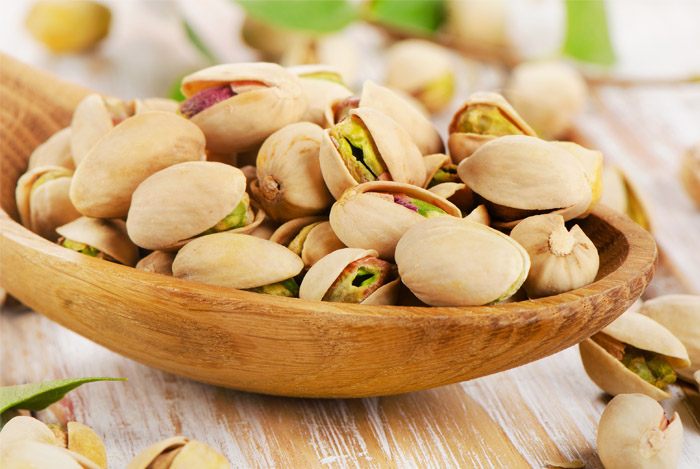 An ounce of pistachios (49 nuts) clocks in at 161 calories, 13 grams of fat, 3 grams of fiber and 6 grams of protein. They also boast almost a fifth of your daily allowance of copper, manganese and vitamin B6.
An ounce of pistachios (49 nuts) clocks in at 161 calories, 13 grams of fat, 3 grams of fiber and 6 grams of protein. They also boast almost a fifth of your daily allowance of copper, manganese and vitamin B6.
2009 research by the University of Texas M D Anderson Cancer Center found that eating two ounces of pistachios daily may reduce the risk of lung cancer and other cancers.
If you’re looking to satisfy your hunger, but watching your weight, pistachios could be a good choice of nut for you.
Not only do you get to eat almost 50 nuts for just 161 calories, but two studies published in 2011 in the journal Appetite have found that in-shell pistachio consumption slows down calorie intake.
Why?
Because the process of having to shell the nuts first slows down consumption, giving your brain time to realize you’re satiated.
The first study found that those who had to shell their nuts before eating ate 41% fewer calories than those who consumed shelled pistachios.
The second showed that the mound of empty pistachio shells can provide important visual cues – reminding you exactly how many nuts you have eaten – which leads to reduced calorie consumption.
In fact, study participants who could see their empty pistachio shells ate 22% fewer calories than those whose empty nut shells were removed.
Walnuts
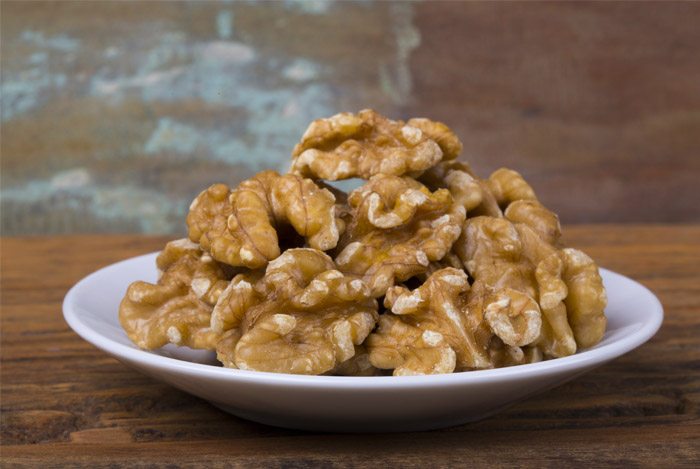 One ounce of walnuts (14 halves) contains 183 calories, 18 grams of fat, 2 grams of fiber and 4 grams of protein. You’ll also be getting 48% of your daily requirement of manganese and 22% of copper needs.
One ounce of walnuts (14 halves) contains 183 calories, 18 grams of fat, 2 grams of fiber and 4 grams of protein. You’ll also be getting 48% of your daily requirement of manganese and 22% of copper needs.
Walnuts are also rich in the plant based omega 3 fatty acid ALA, with a quarter cup containing more than your recommended daily value.
ALA is important for a healthy heart and, in a small study, it was found that eating just four walnuts a day for three weeks can significantly increases blood levels of this essential fatty acid.
Walnuts have also been proven effective at reducing inflammation in the body, along with oxidation in the arteries – which further helps the heart!
In a 2006 Spanish study, participants who added walnuts to a high-fat meal reduced both the inflammation and oxidation in their arteries caused by the fatty food.
Other research has demonstrated a ‘significant’ improvement in cholesterol levels and blood vessel flexibility just four hours after consumption of either walnuts or walnut oil.
Furthermore, those with type 2 diabetes may find walnuts a useful dietary aid.
In a study of diabetic overweight adults, those given a quarter cup of the nuts daily experienced significant reductions in fasting insulin levels within the first three months.
These mighty nuts have also been shown to cut breast cancer risk in animal studies. 2009 research indicates that two handfuls of walnuts per day may keep cancer away or slow tumor growth by 50% in those who already have breast cancer.
Finally, tests on 117 healthy men aged between 21 and 35, who ate a Western-style diet, show that eating 75 grams of walnuts a day for 12 weeks can improve sperm quality, including vitality, motility, and morphology.
Which Nuts Are Best?
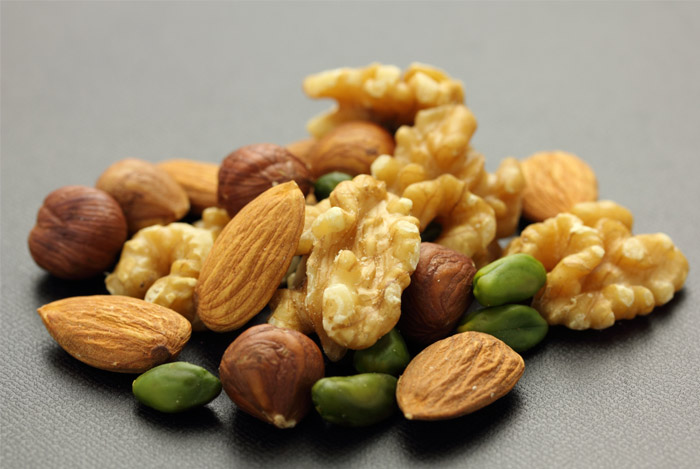 So there you have it…all you need to know about nuts – in a nutshell!
So there you have it…all you need to know about nuts – in a nutshell!
But let’s go back to my original question ‘which nuts are best?’
Just like general nutrition, when it comes to nuts variety is key – at least according to a 2004 review in the Harvard Medical School Family Health Guide.
The guide concluded that mixed nuts, mainly raw and unsalted, provide the best variety of nutrients and antioxidants to meet all our health needs.
Do you eat nuts regularly and, if so, what ones are your favorite? Drop me a comment below!
The post Nuts 101: Which Nuts are Best for You? appeared first on Nutrition Secrets.
http://www.nutritionsecrets.com/which-nuts-are-best-for-you/
No comments:
Post a Comment